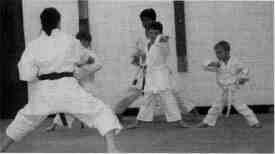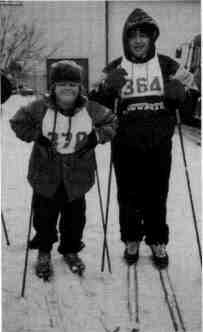
N55RA participant Estee Hoffman has fun with finger paints.

N55RA participant Estee Hoffman has fun with finger paints.
22 / Illinois Parks and Recreation
|
Photo on page 22: |
SPECIAL FOCUS
Special recreation associations or "SRAs" provide invaluable
services to people with physical and mental disabilities
BY JOHN N. McGOVERN, CLP
Illinois is renown for many reasons: among them,
Abraham Lincoln, The Magnificent Mile, U.S.
Speaker of the House Dennis Hasten, and soybeans.
Particularly in park and recreation circles, Illinois is
known nationwide for its unique park district system
and its equally unparalleled yet often misunderstood
special recreation associations.
A special recreation association or "SRA" is a
partnership of two or more park districts or municipalities formed to provide recreation for adults and
children with disabilities and authorized by the Park
District Code. Today Illinois has 26 SRAs made up
of 142 park districts and 24 municipalities.
The first SRA, Northern Suburban Special
Recreation Association (NSSRA), was formed in
March of 1970. Park districts located in the northern
Chicago suburban park districts realized that alone,
they simply could not meet the leisure needs of
children with disabilities in their districts. Having
carefully watched the success of the recently formed
special education cooperative, the Northern Suburban Special Education District, the park districts did
what many of us do: they borrowed someone else's
idea.
As park districts in Deerfield, Glencoe, Glenview,
Highland Park, Kenilworth, Lake Bluff, Northbrook,
Northfield, Winnetka, Wilmette, and other communities began discussions in 1969, three benefits to
participation in a partnership were identified. First,
NSSRA would reduce duplicative supervisory costs,
allowing tax dollars to go to staff who could conduct
programs. This would be accomplished by eliminating the need for a supervisor in every partner agency;
instead, by using a NSSRA supervisor, more resources would go towards direct service staff.
Second, NSSRA would allow partner districts to
serve people with a low incidence disability. The
districts had already learned that if there are only four
kids ages 10 to 12 with a certain disability in one
district, it is hard to program for that group. But, if
there are 4 in Wilmette, 7 in Glenview, 8 in
Northbrook, 3 in Winnetka, 2 in Glencoe, and 7 in
Highland Park, suddenly there are 31 kids ages 10 to
12 with a similar disability in a relatively close
geographic area. That makes programming more
likely to draw the needed minimum number of
registrants.
Third, NSSRA would allow access to enhanced
recreation options. For example, there is not a beach
in Glenview. But through the partnership, Glenview
kids with disabilities would participate in programs at
a beach in Wilmette or Highland Park. And, kids
with disabilities in Glencoe who want indoor skating
can now get it through a partnership program in
Northbrook.
Despite significant changes to the SRA model,
these are still the key benefits of SRA involvement 30
years later.
The SRA Today
Although there is no typical SRA, they share some
common characteristics. SRAs today provide specialized recreation services such as day camps, vacation
trips. Special Olympics, before- and after-school
programs, social programs, and other activities for
people with disabilities. SRAs also provide information about accessible facility design or adaptive
equipment, again in response to community demand.
July/August 1999 23
SPECIAL FOCUS
"We really do serve everybody," says
Craig Culp, superintendent of recreation at
the Maine-Niles Association for Special
Recreation in Skokie (M-NASR), the
second SRA formed, back in 1972.
Culp says M-NASR provides special
services for ages 2 to 80-plus. "Our
participants have physical disabilities,
cognitive disabilities, sensory impairments,
developmental disabilities like autism,
attention deficit-hyperactivity disorder,
cardiac conditions, and some of the so-called hidden disabilities such as diabetes
and epilepsy."
A particularly valuable SRA service is
transportation. Surveys of people with
disabilities in Illinois confirm that the lack
of accessible transportation is one of the
greatest barriers to the use of public
recreation services. SRAs combined
provide hundreds of thousands of rides to
and from programs. Many of the SRAs
operate their own fleets, ranging in size
from one to ten vehicles.
What Do SRAs Cost?
An SRA is an excellent example of local
government cost-containment. The
statutory levy maximum for funding SRA
activities is 4 cents per $100 of equalized
assessed valuation (EAV). The average levy
by a park district or municipality in an
SRA in this fund is just under 2 cents per
$100 of EAV. As partnerships of local
governments, the SRAs have adhered to
the limits placed on the partners regarding
property taxes.
How does this translate for the average
homeowner? In Cook County, the owner
of a $200,000 home pays an average of
$6.40 in annual property taxes for the
SRA. That figure rises in the collar
counties to $13.20. Coffee for two at Starbucks is $6.40 and a pizza costs $13.20. Clearly,
the SRA is an easily affordable cost which, when combined with the partner communities, yields a sum sufficient for a
regional program.
However, costs for special recreation services could not be generated by one agency. Bob Pindar,
director of the South East Association for Special Parks and Recreation (SEASPAR) in Downers Grove,
explains: "The Village of Indian Head Park is the smallest SEASPAR partner and contributes $10,204 this current year. However, our total tax support this year is $702,413. And Indian Head Park residents
have access to all the things we do that are supported by the total tax revenue, not just the $10,000 contributed by the village."
SRAs widely vary in size. Partnerships
range from the two-district agreement in
Champaign and Urbana to the 17 districts
participating in the Northwest Special
Recreation Association (NWSRA).
According to Charlene Holtz, an
attorney for several districts: "SRAs reflect
the similarities and the differences of the
partner park districts. The partnerships
naturally seek some homogeneity. But no
one knows the optimal size.
"For some, 17 seems too big. But for
those 17, it must be right or they would do
it differently. Two is probably too small in
a congested suburban area, but it is perfect
for Champaign and Urbana."
That is a key advantage to the SRA
model. Like an individual buying a pair of
pants, the partnership picks a size that
fits.
The Special Recreation Levy
The Park District and the Municipal
codes include similar provisions that allow
neighboring park districts and municipalities to join together to provide recreation
for people with disabilities. The statutes
offer the incentive of a funding vehicle for
local governments that join together: a
property tax can be levied for joint
agreement purposes. Without a joint
agreement, a park district cannot levy this
tax.
This legislation was guided through the
Illinois General Assembly in 1969 by then
State Senator Harris Fawell. Now a retired
member of Congress, Fawell considers this
one of the best pieces of legislation in
which he has been involved.
"Park districts wanted to serve people
with disabilities and didn't have the
resources to do it right," says Fawell. "The
legislation we passed allowed them to do so
in an efficient way and, importantly, with
little burden on taxpayers.
"We did this because it was the right
thing to do. It was not a response to a state
or federal mandate. It was a result of a
desire to something positive for Illinois
residents."
John Hedges, director of the Park
District of Oak Park, played a key role in
convincing then Senate President Philip
Rock of Oak Park to sponsor a change in
the statute in 1987.
Says Hedges: "The tax rate ceiling was
$.02 per $100 of EAV. The Joint Legislative Committee (an advocacy committee
of the Illinois Association of Park
Districts and the Illinois Park and
Recreation Association) found that most
park districts and cities in an SRA were at
their levy ceiling and were facing rising
demand for service and a growing need to
make recreation facilities accessible."
With the support of the Illinois Taxpayers Federation, the legislation passed the
General Assembly and was signed into law
by Governor James Thompson.
Park districts understand the importance
of supporting recreation for people with
disabilities with this levy authority.
According to Tom Richardson, director
of the Glenview Park District and a
member of the NSSRA board of directors
for almost 20 years: "Next to park land
itself, recreation programs for people with
disabilities can be considered the soul of
public recreation. This is the type of thing
that was made for some form of tax
support.
"Where better to use taxes from
everyone than to help those with disabilities who don't have the same opportunities
to enjoy activities which improve health
and increase self-esteem?"
The Effect of the Tax Cap
Enacted in 1991, the Property Tax
24 / Illinois Parks and Recreation
JUST WHAT IS AN SRA?
Extension Limitation Law or "tax cap" has
affected all park districts and cities, and,
ultimately, their SRA functions. The tax
cap effectively limits the ability of a
partner to increase SRA support.
As demand for recreation services has
continued to rise, unfunded federal
mandates—such as the sweeping Americans with Disabilities Act—have made
park districts and cities aware of other
costs. One such mandate is recreation
"inclusion," whereby people with
disabilities participate in programs
alongside people without disabilities.
Says Liza McElroy, superintendent of
recreation at Winnetka Park District and
president-elect of IPRA: "Inclusion
requires the Winnetka Park District to
provide support such as extra staff, more
training for staff, sign language interpreters, adaptive equipment, accessible
transportation, home visits, and other
modifications so that people with disabilities can choose our programs and participate alongside people without disabilities.
We rely on our SRA (NSSRA) to guide us
through this part of our programs.
"NSSRA spends $300,000 annually for
inclusion in the form of wages for part and full-time staff and materials."
Another ADA-related mandate involves
"accessibility," requiring programs in
existing and new recreation facilities to be
accessible to people with disabilities.
"Water parks, playgrounds, golf courses,
transportation trails, racquetball courts, ice
rinks, and restaurants have all been
reviewed for accessibility here" says Jerry
Handlon, director of the Schaumburg Park
District.
"We understand our obligation to make
these facilities accessible. We wish there
was some way to address this unfunded
mandate, because we do want people with
disabilities in our facilities."
Handlon illustrates this desire with an
access success story involving golf, in
which a father and son were able to enjoy
the game of golf like everyone else
because the district owns an accessible
golf car.
Legislation introduced the spring 1999
session by Senator Kathleen Parker
addresses this problem. Senate Bill 345
excludes the special recreation levy from
the Property Tax Extension Limitation Law
aggregate, freeing it up for use in projects
such as inclusion and accessibility.
"The bill was stalled in the Senate
Revenue Committee because the Senate
was concerned that a change for park
districts and cities in an SRA could have a
domino effect for other similar governmental partnerships," says Larry Reiner,
director of the Northeast DuPage Special
Recreation Association (NEDSRA).
"Kevin Kendrigan at Northwest Special
Recreation Association, John McGovern at
NSSRA, I and others are working with
Senators Christine Radogno, Wendell
Jones, Bill Peterson, and Kathy Parker this
summer to examine this issue and come
up with a solution, because our preliminary research shows no other governmental
partnerships that function as SRAs do."
Variations to the SRA Model
"One of the great things about the SRA
model is its flexibility to adapt to the
community," says Chuck Balling, director
of the Gurnee Park District. Balling served
on the boards of traditional SRAs at
SSSRA and at NEDSRA. While at the
Elmhurst Park District, he was involved in
contracting some special recreation services
to the Ray Graham Association, a large
nonprofit in DuPage County.
Says Balling: "Gateway was a way for
the park district to do more inclusion in-house and privatize some of the special
recreation function."
Balling admits that, like any other
change from the status quo, there are
advantages and disadvantages to the
Gateway system. Today Balling is involved
in another unique SRA. The Gurnee Park
District is a partner in the Warren Special
Recreation Association (WSRA).
"The Township wants to make sure all
its residents with disabilities are eligible for
services, since not everyone in the
Township lives within a park district," says
Brenda Meixelsperger, director of WSRA.
The Township contributes office space
and other resources to the SRA operation
in place of the property tax support
provided by its partner park districts and
villages.
The SRA of Tomorrow
The SRA model will continue to evolve
as park districts and municipal recreation
departments address other issues that fit
into the broad group of disability issues.
This includes recreation programs for at-risk youth, providing services to children
and adults in their homes, and serving
children and adults who not only have
disabilities but are medically fragile. The
spread of technology and the reduced cost
of access to it make it certain that computers and the Web will be an integral part of
SRA operations in the next three years.
As accessible design guidelines for
recreation areas are completed, look for
SRAs to do more training and technical
assistance. Who better to ask about beach
or playground access than the staff at the
park district who work with people with
disabilities?
The SRA model turns 30 in March of
2000. To everyone who shaped this
valuable public service—legislators, park
district or recreation board commissioners,
employees and volunteers—thanks and
congratulations!
JOHN N. McGOVERN, CLP
July/August 1999 / 25Just What Is an SRA?
Today Illinois has 26 SRAs made up of 142 park districts and 24 municipalities.


is the executive director of the Northern Suburban Special
Recreation Association (NSSRA). He is a member of the IAPD/
IPRA joint Legislative Committee and enjoys reading, writing and
talking about the application of ADA to parks and recreation. He
served as guest editor of this special SRA issue of IP&R magazine.
All photos for this article courtesy of NSSRA.